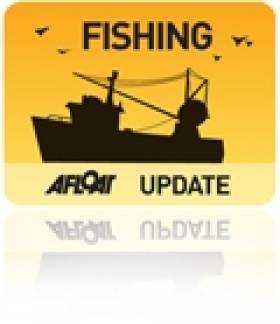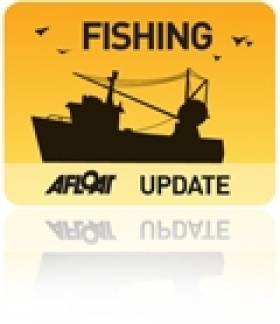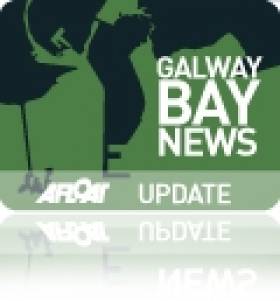Displaying items by tag: Salmon
Applications For 2014 Commercial Salmon Fishing Licences
#Fishing - Inland Fisheries Ireland is inviting applications for commercial fishing licences for salmon (both draft net and snap net) for 2015.
Application forms are available from local IFI offices in Macroom, Limerick, Galway, Ballina and Ballyshannon as listed HERE.
The closing date for receipt of completed applications to the relevant IFI office is 5pm on Monday 23 March. None will be accepted after this date.
First Wild Salmon Of 2015 Landed In Killarney
#Angling - Ireland's first wild salmon of 2015 has been caught in Killarney, as The Irish Times reports.
Local man Jerry Looney landed the 10-pounder a little over half an hour into the opening of the Long Range stretch in the Killarney Lakes.
Even more remarkable is that the 80-year-old's catch is the first salmon to be reeled in since 2009 in the Kerry area.
And it was followed not long after by a 17lb 10oz specimen landed by gillie Brod Sullivan at Lough Currane.
Irish Times angling correspondent Derek Evans has more HERE.
83 Rivers Open For Salmon Angling In 2015
#Angling - In addition to his comments on improvements in Letterkenny fisheries as previously reported on Afloat.ie, Minister of State Joe McHugh has also announced that 83 rivers will open for salmon angling nationwide in 2015.
“Fifty-five rivers will be fully open and this will provide opportunities for all to share this important natural resource on a sustainable basis," said the minister, who added that a further 28 will be open for angling on a 'catch & release' basis.
The total number of open fisheries is down on the 87 rivers opened for 2014, which comprised 57 fully open rivers and 30 catch-and-release fisheries.
Minister McHugh also discussed the further retention of the reduced licence fee for anglers to encourage tourism in the growing sector.
“In 2012 the cost of fishing licences was reduced in the prevailing economic climate and I have decided to maintain that price cut for 2015," he said. "I believe that lower costs will encourage sales of annual licences and continue to incentivise angling tourists to avail of the Ireland’s first-class angling product."
Minister McHugh received management advice in relation to 145 genetically individual wild salmon stocks in Ireland from Inland Fisheries Ireland (IFI) and this advice was also made available publicly as part of a public consultation process. Over 20 submissions were considered as part of the public consultation process.
Management advice was based on the scientific assessment of the current status of all stocks carried out by the independent Standing Scientific Committee on Salmon (SSCE). This committee comprises scientists from IFI, Bord Iascaigh Mhara (BIM), the Marine Institute, the Loughs Agency, the National Parks and Wildlife Service, the Agri-Food and Biosciences Institute (AFBI Northern Ireland), other State bodies and third-level institutions.
In all, the SSCE assessed 145 rivers and has advised that: 55 rivers may open as a surplus of fish has been identified in these rivers; 28 rivers are classified to open for catch-and-release angling; and that 62 rivers should be closed as they have no surplus of fish available for harvest.
Salmon & Sea Trout Fishery Stocks Improve in Letterkenny Fisheries
Mr. Joe McHugh T.D., Minister of State at the Department of Communications, Energy and Natural Resources, has approved a suite of regulations and bye-laws that will govern the wild salmon and sea trout fisheries in 2015. These will come into effect from Thursday 1 January 2015.
Minister Mc Hugh highlighted the progress made in relation to two Rivers in the Letterkenny Fishery District.
The Minister said, "major angling development works are already underway to enhance the highly scenic River Lackagh as a salmon and sea trout fishery. In the latest annual scientific assessment the Lackagh remains open to catch and release angling for 2015 but the deficit in the salmon stock has moved significantly closer to the Rivers conservation limit which once surpassed will facilitate a full opening of the fishery"
"The partnership approach between the Creeslough Angling Club, and Inland Fisheries Ireland (IFI) in a joint management plan for the fishery is making real progress. Salmon numbers have improved steadily on the fishery in recent years with the fishery re-opened on a 'catch and release' basis for the past two seasons. The key issue is to bring the River above its conservation limit and to build on the good work to date. This will require continued collaboration and maintaining patience for the future good of the fishery – it's about staying the course", he added
The Minister recently visited the River to view for himself significant upgrades to facilities along the lower reaches of the river near Creeslough village. The majority of the work was carried out by TUS workers, with materials and additional labour supplied by IFI. The salmon Conservation Fund administered by IFI, has already funded a series of enhancement measures and work in ongoing to secure a major capital project for the fishery next year to install a crump weir and fish counter.
"This is real partnership in the Community with the local club working side by side with the State Agency to enhance their river and its fishery" said Minister Mc Hugh. "The club deserves great praise for its efforts and its forbearance, as do IFI for their excellent support, while we wait for the recovery in salmon numbers to hopefully continue its upward curve" he added.
The Minister also noted the improved stock status in the River Leannan which has moved from being completely closed in 2014 to being open for catch and release angling for 2015. The improved status will allow anglers to catch fish and thereby provide a useful index of salmon numbers in the river before releasing the fish to bolster spawning.
Minister Mc Hugh said, "this is also god news for the Leannan in that it is also moving in the right direction, however all concerned anglers and IFI must nurture this new status and continue to contribute towards building on improvements in the salmon numbers". "While this is a positive development, what the Leannan needs now is again a sense of restraint and a resolution from all stakeholders to ensure that forward movement is maintained" he added.
Inland Fisheries Ireland Opens New Research Facility in Galway
#MarineScience - Inland Fisheries Ireland (IFI) has officially opened a new laboratory at its research facility on its National Index Sea Trout Catchment (River Erriff) at Aasleagh Lodge in Leenane, Co Galway.
IFI says it will continue to invest resources in the Erriff research station, as the outputs from research conducted here will be vital for the future conservation and management of sea trout.
International sea trout expert Dr Graeme Harris, who gave the keynote address at the launch, congratulated IFI on its renewed focus on sea trout and emphasised the importance of world class science on this iconic species.
While research and data collection on both salmon and sea trout has taken place at the Erriff research facilities for over 30 years, a significant new research programme was initiated at the Erriff in 2014.
This new study, which saw the release of sea trout fitted with acoustic tags to sea, aims to investigate migration, distribution, habitat usage and survival of sea trout and salmon smolts in the marine environment on the west coast of Ireland.
Speaking at the launch, IFI chief executive Dr Ciaran Byrne said his organisation "is committed to applied scientific research that is designed to answer important conservation and management questions.
"We have prioritised research on sea trout and are fortunate to have these excellent facilities at this location. We rely on excellent data and scientific analysis which informs future management decisions.”
The Erriff fishery is located at the head of Killary Harbour near the village of Leenane in Connemara. The fishery was purchased by the Irish State from Lord Brabourne in 1982 and has since operated as a salmon and sea trout angling and research fishery.
The river has a large lake in its headwaters, Tawnyard Lough, and a downstream fish trap has operated at the lake exit since 1983. This facility allows assessment of sea trout stocks on an annual basis.
#FishFarm - Undercurrent News reports that Friends of the Irish Environment (FIE) is seeking a High Court injunction against Marine Harvest Ireland over an unauthorised pipeline used to extract water from a freshwater lough to treat salmon at its farm on the Galway coast.
As previously reported on Afloat.ie, the operators of the salmon farm at Kilkiernan Bay installed a pipeline more than 3km long connected to nearby Loughaunore in order to treat an outbreak of amoebic gill disease.
But Galway County Council had not yet made any decision on permitting the pipeline, which was proposed for exemption from standard planning requirements.
The council has since ruled that the development was unauthorised and did require planning permission.
Yet the pipeline remains in place - prompting FIE to seek an injunction against the Irish branch of the Norwegian seafood giant under Section 160 of the Planning and Development Act. More on the story HERE.
Meanwhile, Marine Harvest has been identified as the "most likely" foreign investor to be attracted by the controversial fish farm proposals for Galway Bay and elsewhere, as Victoria White writes in the Irish Examiner.
The columnist visited Inishbofin in Co Galway and Inishturk in Co Mayo, close to the latest proposed location for massive farmed salmon operations, to get the local perspective, and found some vociferous arguments against the shape of BIM's plans - particularly the damaging effects of large-scale monoculture as opposed to smaller but widespread sustainable schemes.
#Angling - Joe McHugh, Minister of State with Special Responsibility for Gaeltacht Affairs and Natural Resources, has announced €230,000 in funding for the rehabilitation of wild Atlantic salmon and sea trout stocks under the Salmon Conservation Fund, managed by Inland Fisheries Ireland (IFI).
Some 24 projects have been approved under the fund, and beneficiaries of this year's scheme include angling clubs, private fishery owners, riparian owners and tourism organisations.
Funds will be distributed across the country with the main beneficiaries undertaking projects on the rivers and tributaries of Castletown, Fane, Dee, Boyne, Vartry, Nore, Suir, Cork Blackwater, Lower Shannon, Newport, Glen and Crana.
The fund was open to contributors to the scheme with works to include: fish passage improvement; spawning enhancement; in-stream structures (such as repairs to weirs, insertion of deflectors, rubble mats, random boulders); river bank protection; fencing to restrict livestock access to the river; and tree pruning, along with the removal and control of exotic invasive species.
These works will contribute towards the rejuvenation of Ireland's wild Atlantic salmon and sea trout stocks with a view to opening further rivers in the coming years to facilitate angling and commercial fishing activities.
The works are seen as an important initiative to conserve, develop and protect the country's valuable natural resources, especially in light of the continued decline of salmon stocks, among other key species, in the Irish Sea.
Minister McHugh commented: "The Salmon Conservation Fund is an annual fund open to contributors to the scheme and I would encourage all those interested in the promotion of our wild Atlantic salmon and sea trout fisheries to consider suitable projects for consideration under the fund for 2015 and beyond."
Full details of the Salmon Conservation Fund can be obtained on the IFI website HERE.
#salmon – Salmon and sea trout from the North Sea will create Yorkshire's most valuable fishery worth at least £12 million a year - in a river barred to them for nearly 40 years.
A barrage on the Derwent river, at Barmby on the Marsh, will be opened eight hours a day from next Saturday (May 24) instead of always being closed. It will allow thousands of salmon and sea trout migrating along the Ouse from the sea to enter the 72-mile river and its tributaries.
It is Yorkshire's biggest river system covering 2,057 square kilometres (794 square miles) and ideal for spawning.
East Yorkshire Rivers Trust masterminded the plan and estimates anglers will now catch 500 salmon and 1,400 sea trout in the river each year.
"That will add £12.5 million to the local economies in Ryedale and districts along the river," said John Shannon, the trust's Derwent restoration project officer.
The barrier was built in the mid 1970s where the river joins the Ouse near Drax power station, to help abstract water. Its boat lock was only opened occasionally so closing off the river to the tidal Ouse and migrating fish.
Mr. Shannon said opening it eight hours a day would safeguard the water supply. Later it was expected to be always open. "With more fish each year there will eventually be ten times more anglers further increasing the benefit to the local economy."
The last time salmon were reported in any numbers in the Derwent was 1976 at Stamford Bridge.
The formal opening of the barrage on Saturday is one of several events in Britain marking World Fish Migration Day.
There will also be an eel stocking when thousands of baby eels will be released. Other fish populations in the river including flounder, lamprey and shad are expected to increase.
At present Yorkshire's most valuable river is the Esk where anglers land 200 salmon and 600 sea trout each year.
East Yorkshire Rivers Trust will be partnered at the event by the Institute of Fisheries Management, the Environment Agency, Natural England and Yorkshire Wildlife Trust.
Space is limited and anyone wishing to attend should e-mail Mr. Shannon at [email protected] to reserve place.
#Angling - The Department of Communications, Energy and Natural Resources has issued new bye-laws for anglers on conservation of salmon and sea trout on three rivers in the West of Ireland.
Bye-law No 917 provides for catch and release in respect of salmon and sea trout over 40cm in length in the Newport River including the waters of Lough Beltra and the Crumpaun River, Co Mayo during the period 20 March to 11 May 2014. More details HERE.
Bye-law No 918 provides for catch and release in respect of salmon and sea trout over 40cm in length in the portion of the Lower Shannon from O’Brien’s Bridge downstream, on the downstream face of the bridge, to Thomond Bridge in Limerick City during the period 1 March to 30 September 2014.
This bye-law also prohibits the use of worms as bait and any fish hooks other than single barbless hooks in angling for salmon and trout in those waters. More details HERE.
And Bye-law No 919 provides for catch and release in angling of salmon and sea trout over 40cm in length in the River Feale, including the Galy and Brick, from 1 March to 11 May 2014, and a bag limit of four fish during the period of 12 May to 30 September subject to a daily limit of one fish during this period.
This bye-Law also prohibits the use of worms as bait and any fish hooks, other than single barbless hooks, in angling for salmon and sea trout over 40cm in length up to 11 May and also from 12 May onwards once the permitted limit had been reached in those waters. More details HERE.
Six More Months Before Any Decision On Galway Bay Fish Farm
#FishFarm - Any decision on the proposed deep-sea organic salmon farm for Galway Bay is at least six months off, as Galway Bay FM reports.
That was the message from the Department of the Marine after Galway TD Eamon O'Cuiv raised the matter in the Dáil this week.
Previously the Fianna Fáil deputy for Galway West had called on Bord Iascaigh Mhara (BIM) to withdraw its application for the 500-hectare fish farm off Inis Oírr in the Aran Islands in light of dispute over the potential impact of sea lice on the region's wild salmon stocks.
His call, in turn, came after the European Commission halted progress on BIM's plans last November amid concerns regarding scientific studies on the impact of disease at what would be the largest aquaculture scheme of its kind in Europe.







































































